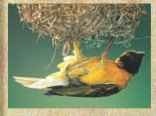ORDER
Passeriformes
FAMILY
Ploceidae
GENUS & SPECIES
KEY FEATURES
African relative of the sparrow, the quelea feeds and breeds in vast colonies over a million strong Descending on cultivated crops to feed, these huge flocks can devastate farmland Although vigorously persecuted as a pest, it has survived everything that people can throw at it
WHERE IN THE WORLD!
Ranges across open grassland south of the Sahara, through East Africa and into southern Africa; absent from North Africa and equatorial forests
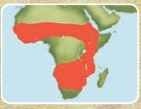
Lifecycle
There is almost no such thing as a single red-billed quelea. The flock travels, feeds, roosts and breeds together in one of nature’s most remarkable examples of community.
HABITAT
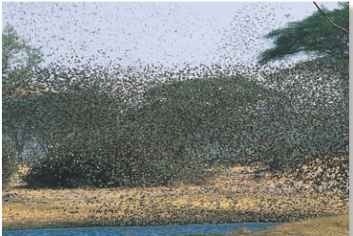
A Birds of a feather… sometimes called the “avian locust,” the quelea flocks over arable land and watering holes.
The quelea ranges in vast flocks over the grasslands and savannahs of sub-Saharan Africa. It’s at home anywhere there are seeds to eat and trees to provide roosts. It can be found over a vast area of the continent. Although these conditions exclude the dense, equatorial forest belt and semidesert, such as found on the Horn of Africa, the quelea is flexible enough to thrive in humid swampland and dry, acacia-dotted savannah.
With large habitat areas being turned over to agriculture, the quelea is being forced to spend more time on arable land.
One tree occupied by breeding queleas had 6,000 nests.
The total population of the red-billed quelea is estimated at one billion.
A feeding quelea’s crop can become so distended, its contents can be identified through the stretched skin.
One quelea flock had more than 80 million birds.
BREEDING
The red-billed quelea breeds in dense colonies. Thousands of pairs rear their young in trees thick with nests. With the onset of the breeding season, the male, in his bright mating plumage, begins building a roughly spherical nest. When half-constructed, he stops work and starts advertising his skills and charms. If a female likes the look of him and his nest, they mate, and he completes the structure.
Both parents feed the brood insects and succulent larvae — a diet that ensures a rich supply of protein and vitamins for the fast-developing young. At 2 weeks old, the young are fledged and ready to leave the nest; two weeks after that they are independent.
BEHAVIOR
Compulsively social, the quelea lives in flocks that can have tens of millions of individuals and darken the sky like a pall of smoke. Wheeling and swirling, the flock-moves together in perfect synchrony like a shoal of fish, billowing across the landscape with a roar of wingbeats. A flock feeding on the ground becomes a sea of tiny, feathered bodies.
Early in the morning, the flock sets out to find food, settling down to feed before it gets too hot. After a midday break in the shade, the birds feed again, and then retreat to roost in trees at dusk. A flock may travel 36 miles or more in a day, moving to new sites several times if food is not plentiful. The quelea does not always live in vast numbers everywhere. Where food is scarce, flocks are much smaller.
One in a million A tightly packed flock is a good defense against hawks and other aerial predators.

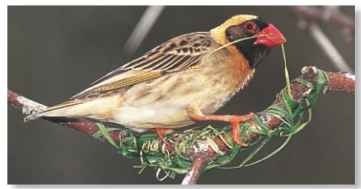
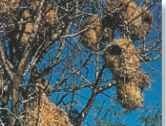
A Show house Nest-building is vital to the quelea’s mating display.
CONSERVATION
Humans have attacked queleas with guns, poisons and even flamethrowers without significant results. However, widespread use of pesticides may be causing real damage.
FOOD & FEEDING
For thousands of years, these seed-eating birds have exploited the wild grasslands in much the same way as herds of grazing mammals. They descend on a verdant area in huge numbers, eat their fill and then move on. Today, much wild grassland has been cultivated for cereal crops, irresistible pickings for a quelea flock.
The quelea’s stout bill is perfect for cracking husks. Worked by strong muscles, its mandible can easily crush tough grass seeds and make light work of softer; cultivated grasses. A visit from a flock of queleas can spell disaster for an African cereal farmer:
A FINE FEAST

Gathering for dinner…
A vast flock of red-billed queleas sweeps across the land. A tasty crop of ripe grain attracts them.
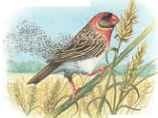
Places please…
Each of the million or more birds has a hearty appetite. It hops from stem to stem, stripping the seedheads.
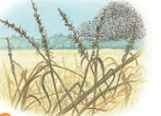
Clean sweep…
Within a few hours, the crop is ravaged and worthless to the farmer. The flock swirls away.
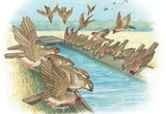
Washing it down
Returning to their roost, the birds stop off for water, some swooping down to collect it on the wing.
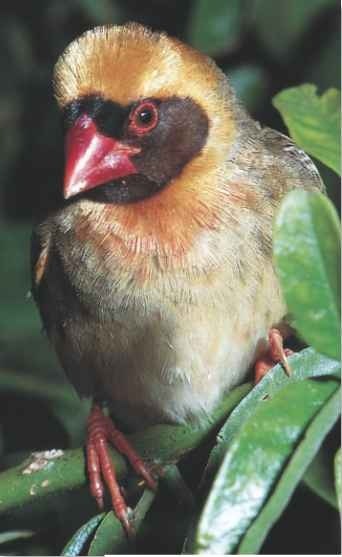
PROFILE
Red-billed Quelea
The red-billed quelea looks innocent enough on its own, but in a flock a million strong, it is one of the most feared creatures in Africa.
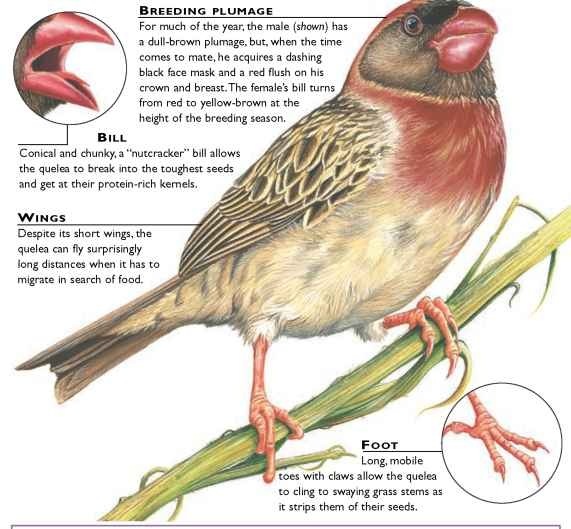
CREATURE COMPARISONS
One of the quelea’s more colorful relatives is the golden palm weaver (Ploceus bojeri), an elegant, sparrow-sized bird that is common on Kenya’s Indian Ocean coastline. Here it feeds in small parties among the palm trees and shrubs near the shore, flitting through the foliage in search of berries and other fruit. Like the red-billed quelea, and-most other weavers, the male builds an elaborate, suspended nest from woven grasses and attracts a mate, using a spectacular display of plumage.

| VITAL STATISTICS | |
| Weight | 0.7 oz. |
| Length Sexual Maturity |
4.5-5″ 1 year |
| Breeding Season | Start of tropical rainy season |
| Number of Eggs | 2-4 |
| Incubation Period | 12 days |
| Fledging Period | 14 days |
| Breeding Interval | 1 year |
| Typical Diet | Seeds and grain |
| Lifespan | About 3 years |
RELATED SPECIES
• The red-billed quelea is 1 of 94 species of true weaver bird, and I of 3 in its genus. True weavers, along with other types of weaver, whydahs, snow finches and sparrows, form 143 species in the Ploceidae family, including the village weaver, Ploceus cucullatus (below).
